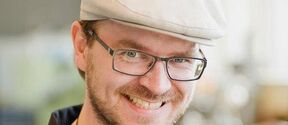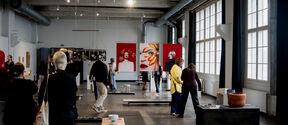Professor Marco Steinberg: ’We need to change, and we need to do it now’

What is your professorship about?
It is about applying design in a strategic capacity to help address complex socio-economic challenges. In practice this is less about products and services and more about systems and transformation.
To be honest, at first I was perplexed by the presence of the term industrial design in my academic title. For close to 20 years I’ve been working under the rubric of Strategic Design. But then I realized I needed to conceptually reframe my thinking. The Industrial Design part of the title should not be understood as the design of the products of industry (as we might normally think), but rather as the design of industry itself. So in the end, this extension had interesting complementarities.
What brought you to Aalto?
It was an unexpected journey.
In 1999 I joined the faculty of architecture at Harvard University’s Design School. That was a very educational period for me, but after 10 years I felt that I was ready for new challenges. At Harvard I had begun to see how design could have an important role outside of its traditions in products, buildings, or services. I had built enough experience applying design in complex, socio-economic challenges, and was keen to get closer to practice.
In 2013 I came back to Finland, working for the Finnish Innovation Fund as Director of Strategic Design. The first such position there, and possibly the last (he laughs). I was keen to ensure that we designers don’t inadvertently contribute to the problem by making today’s flawed solutions more pleasant; more user-friendly. I wanted to ensure that while we deliver better products and services we also have the capacity to make sure we are asking the right questions; that we contribute positively to the broader direction of travel. Today I work for government and development agencies around the world, and see a growing gap for design to get involved in.
Last year, 15 years since leaving academia, I started to realize I was getting this itch to teach again. I guess I’m at a point where I want to make sense of the practical experience I’ve gained so far. What better clarifier of the mind than teaching!
Another draw was the international community at Aalto. While I’m Finnish, I’ve lived most of my life abroad. Up until now, being back home in Finland has come with a bit of trade-off. While it has been great for our family’s quality of life, it has meant giving up the richness of ideas and experiences that comes from being abroad. But now I can have my cake and eat it too; I’m living at home, but it feels like I’m working abroad. And to do that without travel is truly fantastic!
Professor Marco Steinberg‘To me, strategic design is a leadership model; a way to lead in times of uncertainty and complexity.’
What have been the highlights of your career?
There are many, but I want to focus on one experience that put me on an unpredictable, but ultimately quite profound trajectory.
In 2004, as an Associate Professor at Harvard, I had the opportunity to lead a healthcare redesign initiative. It was called the Stroke Pathways Project. It was built on the realization that at its core healthcare is not a medical, business, organizational, or financial challenge. It sat at the intersection of all of those in a complex systems problem. In other words, for me it was fundamentally a design problem.
I led a team across our medical and business schools, focusing on a single specific condition, strokes. The idea was that “healthcare” is too broad, unbound an issue. However, by following a single disease path from cradle to grave we could get a very precise section across the system. We could understand how patients and caretakers experience it at various points, and how the dynamics that governed the system, from organizations and clinical trials to reimbursements, behaved. This gave us a holistic perspective of what drove outcomes, from prevention through acute care to long-term management, rehabilitation, or cure. This was politically relevant too. Because decision makers sometimes only see the parts rather than the whole of a problem, they may be blind-sided by the unintended consequences of their choices. Without this full-cycle perspective, “solutions” may only shift costs and problems from one part of the cycle to another.
This work generated many things. First, it produced a strategic design roadmap for delivering better stroke outcomes at lower costs.
But secondly, it helped me develop the experience and methodology for looking at, and operating within, complex development challenges.

What do you research, and why?
My professional work tries to connect two ends of a broad spectrum. On one end I work on specific government challenges, such as aging communities, energy or employment, in specific contexts, such as Uruguay, Myanmar, or Palestine.
On the other end of the spectrum I work with government organizations to help them operate more effectively. This might mean helping change their internal rules and regulations in ways that can lead to new, and more effective, ways of working. The promise is, that if we can help change how institutions behave, then this can lead to new kinds of outcomes.
What topics are current in your field right now?
It’s a broad spectrum. Some of the topics in which colleagues and I share common interests include economies of care, 15-minute cities, future food systems, climate change, and institutional design. Some colleagues are working on fascinating topics like urban technology or global and nuclear security. There is also a general interested in exploring models for teaching strategic design; what is teachable, and what we can do to help build capacity at scale.
What expectations do you have for your field?
This moment feels a bit like shooting towards the moon. A small change in direction today can have a huge impact on where we will land tomorrow. We have an acute need for strategic improvement in how our societies, governments, and businesses are organized and behave. There are no off-the-shelf solutions as to how to do that. Design has an important role in this.
The next 5 to 10 years feel like a fairly decisive window. We will need to build the field while also actively contributing to broader change. In other words, we will have to change the tire while driving the car. I think students have it in them to operate differently, the question is: what about everyone else? I think we are on the cusp of transforming a lot of things, including how the academy operates. So fast, furious, and exiting times ahead.
Why should one study strategic design?
We are living in an age-defining period. While the news is not always uplifting, we need to remember that we have extraordinary agency in what happens next. A better future, however,
won’t be born out of an extension of past logics. This is a deeply creative endeavor, one that will need to leverage design in its most strategic capacity.
What else are you interested in?
In recent years I’ve become increasingly interested in the psychology of creativity. So I try to pick up a book or article from time to time.
More broadly, I’m interested in people, food and sports. People, because I’m human; food, because I find cooking therapeutic and food itself an interesting vehicle to experience and talk about quality; and sports, because it can be more than a game.
At their core, sports capture the essence of society. During a game you will find yourself passionately discussing questions about right and wrong, arbitration, rules, teams, conduct, skills, strategy, etc. You can literally have a very sophisticated socio-economic discussion by watching football.

Who?
Position: Professor of Practice, Strategic and Industrial Design at Aalto University starting 1.8.2023
Other: Founder of Snowcone & Haystack (2013) a strategic design practice helping governments and leaders innovate. Honorary Doctorate from Delft Technical University (TU Delft)
Background: Born in Finland, grew up in Italy, studied architecture and taught extensively in the US
Education: Rhode Island School Of Design, Bachelor of Architecture and Bachelor of Fine Arts; Harvard University, Master of Architecture
Age: 55
Family: married, 2 children
Hobbies: Hobbies require regularity and leisure time. I’m sad to say I’m short on both.
Contact: marco.steinberg@aalto.fi
Read more news

Meet Shaya Vosough, assistant professor of transportation engineering
Shaya Vosough seeks to understand our travel choices and how they are influenced.
Meet Sampsa Laakso, assistant professor of manufacturing processes and systems
Assistant Professor Sampsa Laakso is an expert of virtual manufacturing.Growing Materials, Growing Ideas: Inside the BioMaker Studio
At Aalto University’s BioMaker Studio, initiated by Ena Naito, students and researchers experiment with living materials, from algae to mycelium, creating an open, interdisciplinary space where design, biology, and collaboration grow together.






